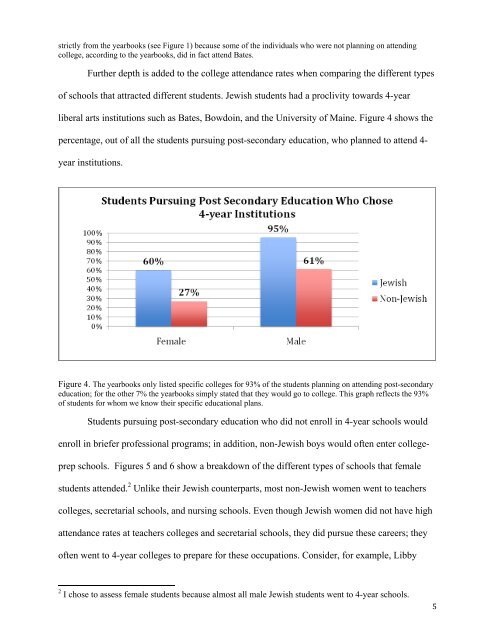College Attendance Among Jews in Lewiston, Maine, During the ...
College Attendance Among Jews in Lewiston, Maine, During the ... College Attendance Among Jews in Lewiston, Maine, During the ...
important to acknowledge that in 1930, some students graduated high school at age 18, while many others graduated at ages 16 and 17. Therefore, school attendance rate among 18-20-year- olds does not directly correlate with the college attendance rates. Although the data is indeterminate, the school attendance rates of Jews and non-Jews ages 18-20 are sufficiently different to provide evidence of major differences in the educational patterns within these populations. Figure 3 shows that in the time between 1927 and 1940 there was little variance in the Jewish college attendance rate. The overall average attendance rate of 62% is almost equivalent to the trend line, or the linear approximation. It is interesting that the college attendance rate did not increase as time progressed, as this is what might have been expected. Because the variance in college attendance rate is not a function of the progressing years, it is appropriate that this study analyzes all of the students from this time period in a single data set. Figure 3. This data represents all of the Jewish students who graduated from 1927 through 1940 listed in the yearbooks. I did not, however, rely exclusively on the yearbooks to calculate college attendance rates: I also used Bates College enrollment records. The overall average rate of 62% is higher than the averages that were obtained 4
strictly from the yearbooks (see Figure 1) because some of the individuals who were not planning on attending college, according to the yearbooks, did in fact attend Bates. Further depth is added to the college attendance rates when comparing the different types of schools that attracted different students. Jewish students had a proclivity towards 4-year liberal arts institutions such as Bates, Bowdoin, and the University of Maine. Figure 4 shows the percentage, out of all the students pursuing post-secondary education, who planned to attend 4- year institutions. Figure 4. The yearbooks only listed specific colleges for 93% of the students planning on attending post-secondary education; for the other 7% the yearbooks simply stated that they would go to college. This graph reflects the 93% of students for whom we know their specific educational plans. Students pursuing post-secondary education who did not enroll in 4-year schools would enroll in briefer professional programs; in addition, non-Jewish boys would often enter college- prep schools. Figures 5 and 6 show a breakdown of the different types of schools that female students attended. 2 Unlike their Jewish counterparts, most non-Jewish women went to teachers colleges, secretarial schools, and nursing schools. Even though Jewish women did not have high attendance rates at teachers colleges and secretarial schools, they did pursue these careers; they often went to 4-year colleges to prepare for these occupations. Consider, for example, Libby 2 I chose to assess female students because almost all male Jewish students went to 4-year schools. 5
- Page 1 and 2: College Attendance Among Jews in Le
- Page 3: While Figure 1 represents students
- Page 7 and 8: Figure 6. Representative of 377 non
- Page 9 and 10: suggest a correlation between famil
- Page 11 and 12: Clearly, economics alone cannot acc
- Page 13 and 14: Figure 10. The students represented
- Page 15: Works Cited Freidenreich, David, an
strictly from <strong>the</strong> yearbooks (see Figure 1) because some of <strong>the</strong> <strong>in</strong>dividuals who were not plann<strong>in</strong>g on attend<strong>in</strong>g<br />
college, accord<strong>in</strong>g to <strong>the</strong> yearbooks, did <strong>in</strong> fact attend Bates.<br />
Fur<strong>the</strong>r depth is added to <strong>the</strong> college attendance rates when compar<strong>in</strong>g <strong>the</strong> different types<br />
of schools that attracted different students. Jewish students had a proclivity towards 4-year<br />
liberal arts <strong>in</strong>stitutions such as Bates, Bowdo<strong>in</strong>, and <strong>the</strong> University of Ma<strong>in</strong>e. Figure 4 shows <strong>the</strong><br />
percentage, out of all <strong>the</strong> students pursu<strong>in</strong>g post-secondary education, who planned to attend 4-<br />
year <strong>in</strong>stitutions.<br />
Figure 4. The yearbooks only listed specific colleges for 93% of <strong>the</strong> students plann<strong>in</strong>g on attend<strong>in</strong>g post-secondary<br />
education; for <strong>the</strong> o<strong>the</strong>r 7% <strong>the</strong> yearbooks simply stated that <strong>the</strong>y would go to college. This graph reflects <strong>the</strong> 93%<br />
of students for whom we know <strong>the</strong>ir specific educational plans.<br />
Students pursu<strong>in</strong>g post-secondary education who did not enroll <strong>in</strong> 4-year schools would<br />
enroll <strong>in</strong> briefer professional programs; <strong>in</strong> addition, non-Jewish boys would often enter college-<br />
prep schools. Figures 5 and 6 show a breakdown of <strong>the</strong> different types of schools that female<br />
students attended. 2 Unlike <strong>the</strong>ir Jewish counterparts, most non-Jewish women went to teachers<br />
colleges, secretarial schools, and nurs<strong>in</strong>g schools. Even though Jewish women did not have high<br />
attendance rates at teachers colleges and secretarial schools, <strong>the</strong>y did pursue <strong>the</strong>se careers; <strong>the</strong>y<br />
often went to 4-year colleges to prepare for <strong>the</strong>se occupations. Consider, for example, Libby<br />
2 I chose to assess female students because almost all male Jewish students went to 4-year schools.<br />
5



